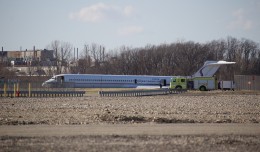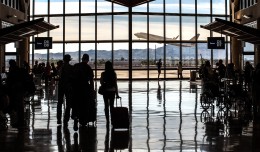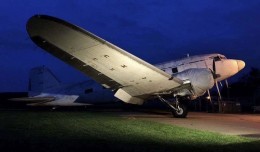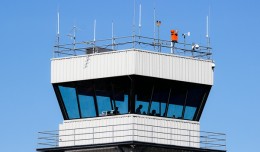The mysterious disappearance of Malaysian Airlines Flight 370 has brought with it much speculation. Instantaneous inflight breakup, terrorist bombing, missile, even a tragedy similar to Air France Flight 447. As of this writing, the plane has still not been found. However, short of an instantaneous and catastrophic event, what could the team of pilots up front do to save a broken ship?
You’re the Captain of Fantastic Airlines Flight, 123. You’re an hour into your flight from Paris to Tokyo, cruising over the Baltic Sea at 40,000 feet. You’ve assigned PF (Pilot Flying) duties to your trusty FO (First Officer) Mark, who is flying the plane on autopilot. As PNF (Pilot Not Flying) on this leg, you work the radios and run support. In the two cockpit jumpseats behind you sit your IROs (International Relief Officers,) who are just about to take over for the middle part of the 11-hour flight while you and Mark go to the back and rest up for landing. You reach for the Flight Attendant call button. But suddenly . . .
BOOM! Explosive decompression!
For the next ten seconds, the cockpit becomes a hurricane, with papers and small loose objects flying. The windows frost over. Suddenly, the temperature plummets to minus a jillion. You, Mark and the two IROs all frantically snatch and don your full face oxygen masks. No time for checklists; at 40,000 feet, you have a mere 15-20 seconds of useful consciousness.
With a hiss, the mask sucks snugly around your head. Fumbling in the blind (the oxygen mask is also fogged over) you select 100%, forced flow. You peel away the thin plastic anti-fog lining and suddenly you can see again. “I have the aircraft!” you shout. “You have the aircraft!” your FO, previously the pilot flying, acknowledges. You reach to kick off the autopilot—and realize it has already disengaged itself. You grab the yoke. Simultaneously, you ease the nose over into a high dive, simultaneously cutting the engine power to idle. You need to get down ASAP, but you dare not increase speed: the aircraft has no doubt suffered structural damage. She’s still alive and flying, and you want to keep her that way.
She’s sluggish, her right wing shuddering and trying to drop, the tail yawing hard to the right. You kick in left rudder and hold left aileron just to keep her going straight. The hurricane is gone, but there’s still a cacophony of sound assaulting your ears. DING! DING! DING! goes the Master Caution, flashing red and competing with a dozen amber emergency procedures suddenly popping up on your ECAM (Electronic Centralised Aircraft Monitor), all clamoring for your attention.
The FO silences the Master Caution. “Mayday, mayday,” he yells out on the radio, his shouts muffled by the microphone in his O2 mask. “Fantastic Flight 123, declaring an emergency. Explosive decompression, executing a rapid descent. Turning off course to heading 360.” In back, you hear screams and someone making a PA announcement. You can’t make out the words, but you know it’s a flight attendant bleating out instructions and imploring everyone to stay calm, while shouting in a frantic, panicked voice herself. Then the screams and PA suddenly go silent. They’ve either donned their own masks, automatically deployed by the pressure loss—or they’ve all passed out. There is one more noise though: that of rushing air. Somewhere back there, you have a gaping hole in your machine. But you already knew that.
The altimeter blazes through 32,000’, spinning backwards like a madman’s time travel clock. Your vertical speed, normally 1-2,000 feet per minute up or down, is now passing through 8,000 fpm. You’re over water for the moment, so you’re aiming for an altitude of 10,000’. “Call the back,” you order. “We need to know what’s going on.” “Already did, Cap’n,” your trusty FO replies. “No response.” Not surprising. They’re probably all out cold. Just in case, you toggle the PA switch. “This is the Captain,” you say, in the most calm, commanding voice you can muster. “Remain seated. The situation is under control.” That’s all you have time to say. Right now, you’re a tad busy working on that little bit about, “the situation is under control.”
“Explosive decompression Checklist,” you order. It’s a backup for what you’ve already done, but you need Mark to read it, just in case you’ve missed something. And in the “fog of war,” even the best-trained pilot can easily miss something. Again, Mark has already anticipated your next command, and has the QRH (Quick Reference Handbook) out and ready to read. You’ve got your hands full flying the plane, so he reads and does it aloud.
“‘O2 Masks—Deploy’ he quotes. Deployed. ‘Cabin masks—Deploy’ Deployed . . . Turn off the airway and descend to MEA (Minimum Enroute Altitude) as soon as possible. Do not exceed speed at time of failure. Assess damage and adjust flight path and controls accordingly. Land at nearest suitable airport.’ Explosive Decompression Checklist complete!”
“Roger that,” you reply. “MEA’s below 10,000, so that’s where we’re headed for now.” The airspeed begins to increase. You gingerly pitch up to bleed it off. A glance at the altimeter: 25,000 feet. You’re low enough now to ease in some speed brakes. Instantly, the plane begins to shudder violently. No good. You ease the brakes back off. It’s then you notice: the right engine’s out—and on fire.
“ECAM actions,” you bark. Mark reads the top checklist that’s popped up on your screen. “Engine Number Two, failure and fire, Skipper.” “Understood,” you reply. Mark begins reading and doing the on-screen emergency checklists. “‘Engine two thrust lever—idle’ idle. Engine two master switch—off,’ confirm?” he asks. His hand is poised to pull the number two kill switch, but again in the fog of war, the last thing you want to do is shut down the wrong engine. With your right hand you cover the working engine master switch. “Confirm,” you reply. “Off! ‘Engine Two Fire Bottle—Discharge’” There is a brief pause, before Mark announces, “The fire’s out, Captain,” with an obvious sound of relief in his voice. “Roger that, continue with ECAM actions.”
You glance behind at the IROs. Strapped in and masks on, they look back at you. You have an idea. While Mark has his hands full securing the plane with oodles of checklists, you’ve got two fully qualified pilots at your disposal sitting right there. “Kathy,” you call to the first relief pilot, “I need you to get back there and see what’s going on. Don the PBE (Portable Breathing Equipment) and take the crash axe. If they’re all out, put masks on our gals up front and try to revive them. And if you see any structural damage, get back here and report it ASAP!” “Aye aye, Cap’n!” comes her smart response. “Charlie,” you call out to the second pilot, “get up here and find us the nearest suitable pavement.” “Yes, sir!” Charlie springs out of the jumpseat, kneels by the pedestal, and punches data into your flight computer.
“Captain,” the FO chimes in. “Yeah, Mark?” you reply. “ATC advises Stockholm’s 170 miles ahead, about 10° right of course. Denmark’s behind us 250 miles.” Damn. You missed that radio call. The fog of war again. You contemplate the situation. Denmark’s behind you, and nearly twice as far, while requiring twice as much maneuvering. And you still don’t know what’s going on with the plane. “Stockholm sound good to you, Mark?” “Affirm, Captain,” he replies. “Charlie?” comes your next query. “Agreed, sir.” “OK, looks like we’ll be partying with the Swedish Bikini Team tonight,” you say, hoping the joke will relieve a little of the tension. “Tell ATC that we want vectors for Stockholm Arlanda.”
As Pilot in Command of an emergency aircraft, the world is at your beck and call. You don’t ask, you tell. You read the altimeter. Blasting through 16,000 feet. You ease back on the stick, coaxing the plane out of its earthly plummet, aiming for 10,000 feet level off. You pull the mask off. “Captain,” Kathy chimes in, back from the cabin. “Everyone’s knocked out back there. No injuries that I can see. Flight attendants are groggy but coming to.” “Damage report?” you ask. Kathy takes a big breath. “The second, aircraft-right, overwing exit is gone. It looks like it ripped into the upper right wing and took out a few spoilers in the process. Thank God the overwing slides didn’t deploy. Yet.” “Roger that,” you reply. “Fire?” “No flames from number two engine, just smoke now. It’s just out there windmilling, so it looks like you gents got ‘er shut down properly.” “OK good. You two to get back there and help the flight attendants check all passengers out. They should be coming to soon. Double check for any injuries and all seat belts locked tight. If anyone is freaking out over the missing door nearby, try to reseat them.” “Aye aye,” they reply.
The next half hour goes by in a blur. The checklists have all been run, and the cabin has been secured for an emergency landing. On touchdown, you’ll have only one thrust reverser. However the landing gear has mercifully deployed, with all brake systems reporting green. You have elected to land on Stockholm Arlanda’s Runway 01L. At nearly 11,000 feet, it’s the airport’s longest. You’ve also chosen not to deploy the flaps due to the structural damage, so you’ll be coming in mighty hot.
As the air gets thicker, you notice that the aircraft is becoming difficult to control. Your left leg is throbbing from fighting the rudder all the way down. Through gentle yoke movements and a lot of hard rudder, you’re finally lined up on final approach. The runway looms ever closer in the windshield. At 500 feet above the ground, you toggle the PA. “This is the Captain. Brace for impact.”
“Over the fence, on target, sink 800,” Mark announces. You pull the yoke up slightly and the airplane flares. The plane slams onto the runway, but you knew it would. There is no time for finesse under the circumstances. At least she’s on the ground in one piece. Well, two pieces. You left a door somewhere back there in the Baltic Sea.
You press the toe brakes and throw number one into full reverse, fighting the sudden left yaw. The plane shudders and screams. And then, finally, it stops. You set the parking brake and toggle the PA one last time. “This is the Captain. Remain seated. The situation is under control.” The cabin erupts in cheers. You take a deep breath, your heart pounding. Suddenly you notice about 200 TV trucks and cameras behind the airport fence, broadcasting you on a live feed to around the world. Book deals, endless talk shows and somewhat unwanted fame is in your near future. But for now, you’re just thankful to be alive. Everyone wants to hail you as a hero. Even your own flight crew now wants to pat you on the back. You shrug, and say something you’ll be repeating on TV talk shows for years to come:
“I was only doing what I was trained to do.”
Eric “Cap’n Aux” Auxier is an airline pilot by day, writer by night, and kid by choice. An A320 Captain for a major U.S. airline, he is also a freelance writer, novelist and blogger (capnaux.com). His second novel, The Last Bush Pilots, captured the coveted Amazon TOP 100 Breakthrough Novels in 2013. Mr. Auxier makes his home in Phoenix, Arizona.








